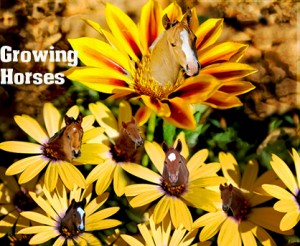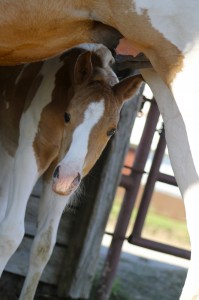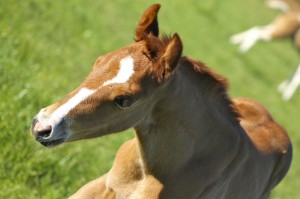Growing Horses
Few topics in equine nutrition stir more controversy than feeding the growing horse. Many factors add to the confusion of providing nutrition throughout these critical stages of life. For example, growing horses may have different commercial endpoints. Some will be shown in halter futurities, where maximum growth and condition are required at a young age. Others will be prepared for sale, again requiring a “well-grown” individual. Still others will be kept on the farm to be used as replacement horses or future performance horses. These horses often have less pressure on them to look their best at a young age.
A healthy foal will grow rapidly, gaining in height, weight and strength almost before your eyes. From birth to age two, a young horse can achieve 90 percent or more of its full adult size, sometimes putting on as many as three pounds per day. Feeding young horses is a balancing act, as the nutritional start a foal gets can have a profound effect on its health and soundness for the rest of its life. At eight to ten weeks of age, mare’s milk alone may not adequately meet the foal’s nutritional needs, depending on the desired growth rate and owner wants for a foal. As the foal’s dietary requirements shift from milk to feed and forage, your role in providing the proper nutrition gains in importance.
The critical nutrients for growth are energy, protein (amino acids), minerals and vitamins. Nutrition imbalances have been recognized as one potential cause of growth disorders in young growing horses. Therefore, it is important that the diets of young horses be properly balanced with nutrients known to be critical to proper development.
When you plan a feeding program for your young horses, several factors are very important:
• Body changes involved in growth
• Nutrient requirements of that particular class of horse
• The feed’s nutrient content
•Anatomical limitations of young horses’ digestive system. For instance, you cannot feed young horses’ low-energy, bulky feeds, because their digestive tracts are not large enough. Instead, young horses need concentrated sources of energy, protein, vitamins and minerals to meet their nutritive needs.
The Nursing Foal
Foals will meet their nutritional requirements in their first two to three months with mare’s milk and pasture, plus whatever feed they start nibbling on. If a foal and mare are in good condition, the foal does not need to start creep feeding until it is at least two months old. However, some may need to start creep feeding by 30 days of age. In the third month of lactation, the mare’s milk production drops while the foal’s nutritional needs keep increasing. Therefore, foals have a nutrient gap. Creep feeding (that is, using feed that the mare cannot get to) can provide the foal with extra nutrients to fill this gap.
Several aspects of creep feeding are very important:
• Start creep feeding when foals are about 8 to 12 weeks old. Make sure the feed is fresh daily and that foals are consuming it adequately.
• Use a creep feeder designed so that mares cannot gain access and so that foals will not be hurt. If you do not want a field type feeder, you can tie the mare in her stall, allowing the foal to eat.
• Put the creep feeder where mares gather frequently.
• Feed the creep feed at a rate of 1% of the foal’s body weight per day (max – 1 lb. /100 lb. of body weight).
The Weanling
Generally foal performance decreases immediately after weaning. To minimize this “post weaning slump,” make sure foals are consuming enough dry feed at weaning to meet their requirements. One way of doing so is by creep feeding. Managing growth during this time is very important because excessive weight gain may cause bone abnormalities and long-lasting skeletal problems.
Feed weaned foals on a combination diet. First, they should be fed good quality forage. They should have access to all the good quality hay they will consume and allowed all the voluntary exercise they want. Research has shown that exercise strengthens bone, increases cortical thickness and makes for a more durable future athlete.
Second, weanlings also should be fed concentrates at the approximately the following rate: one pound per month of age per day (depending on the recommendations listed on the product). Be careful not to feed weanlings too much levels of concentrates, they will grow more rapidly and this rapid growth may harm skeletal and tendon development. Therefore, adjust feed intake to avoid overfeeding.
The Yearling
Because their growth rate slows considerably by 12 months, yearlings can consume more pounds of dry matter. Therefore, they need lower nutrient concentrations in their ration. Feed grain to yearlings at approximately 0.5 to 1lb/100 lb of body weight. Even though yearlings require only 12% CP in the total ration, a 14% CP concentrate ration gives you more flexibility. With this level, even if you use different types of hays with protein variations, the horse will still get enough protein. An 800 lb yearling may receive 7 to 10 lsb of concentrate per day plus free choice hay or pasture. The amount of concentrate required varies due to forage quality and quantity.
By the time yearlings are 18 months old (long yearlings), their growth rate has slowed even further. Although long yearlings only require 10% protein, you do not need to formulate a new ration for them. You can feed them the same ration as 12 month yearlings get. Because horses have highly individual natures, you need to adjust feed consumption to account for changes in individual condition. Some horses are easier to maintain than others. Therefore, you must combine your knowledge of nutrition, your eye for condition and your common sense to make the final adjustments on feed intake.
dac® offers several options to meet the needs of growing horses. dac® Colt Grower is a concentrated vitamin and mineral supplement that contains optimal levels of bioavailable minerals to ensure enhanced uptake and absorption. Providing essential protein, energy and balanced levels of macro and micro nutrients is essential to ensure health, and optimum growth. dac® “CMZ” Colt Builder paste is provides a balance of vitamin and minerals profile for young horses experiencing skeletal growth problems. Vitamins and minerals play a critical role in numerous metabolic functions including: reproduction, bone development, nerve function, immune function, hoof, skin and coat quality as well as energy balance.













